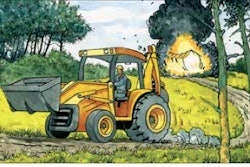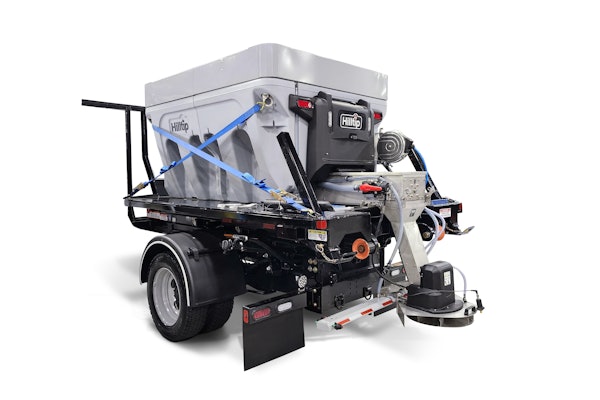For years, tractor loader backhoes were used for general landscape jobs. New landscapers often start their equipment portfolio with a loader backhoe, whether for the detachable backhoe or to mount a box scraper for grade work. Though loader backhoes have high horsepower, this equals a physically larger machine – not always the best thing when you’re working in an urban setting, a small backyard or bringing equipment through a narrow gate. This is where the compact excavator shines.
Introduced to the U.S. market in the 1970s, compact excavators are heralded as the go-to machine for many landscapers, especially those installing water features, replacing an existing patio or building retaining walls. “When coupled with a skid steer, the compact excavator is a lot more versatile in jobs traditionally done by a loader backhoe,” says Jim Hughes, brand marketing manager, Case Construction Equipment. “The compact excavator is easier to trailer from job to job and is much smaller in terms of its footprint.”
Fitting it in
Compact excavators are perfect for backyard work. Most easily fit through, or can retract their undercarriage to fit through, standard garden gates. Once in position to work, the undercarriage can be widened for stable operation. “Compact excavators have more power for their size. With a loader backhoe, you can only use it in a certain range and have to reposition often,” says Bryan Zent, marketing manager, Bobcat. “The efficiency of the compact excavator is proved with its capability to spin around and dig in any direction.”
Most landscapers prefer zero-tailswing models – which allow the upper carriage to stay within the width of the tracks – because they can be operated alongside houses or in tight spaces without damaging existing structures or plant material on a jobsite.
“Contractors have really come to depend on compact excavators in the installation of ponds,” says Rick Harris, senior product manager, Terex Construction. “A contractor can come in, dig out the pit for the ponds, and then come back through with a vibratory compactor and further pack the soil.” A grapple bucket attachment helps place large boulders and stones around the pond without being more invasive to the landscape than necessary.
Making your mark
One of the biggest considerations when purchasing a compact excavator is whether to equip it with steel tracks, rubber tracks, or a hybrid version. Making the wrong decision could come with an expensive price tag. Tracks offer better flotation and less ground disturbance than the wheels on a backhoe loader because weight on tracks is distributed through the length and width of the pad.
Most manufacturers agree steel tracks are not the best option for a landscape operation.
They leave significant marks, not only in turf, but on concrete and asphalt. However, Keith Rohrbacker, product manager for compact excavators, Kubota, explains steel tracks can be OK if you’re just running the machine across turf. While tracks leave 1/2-inch lines, the small machines landscapers use don’t put a lot of pressure on turf.
Rubber tracks are the most popular choice among landscapers, and for good reason. They can transition from concrete to turf and provide excellent flotation. “You definitely want to use rubber tracks on established turf,” Hughes explains. “You don’t want to go in with a wheeled piece of equipment because they can cause ruts and turf damage, which you will have to replace, and time is money.”
If the machine is going to be used in a variety of applications, Jay Baudhuin, compact equipment product manager with Wacker Neuson, recommends using hybrid tracks, which combine the advantages of rubber and steel tracks. “The hybrid track is a series of rubber pads which are reinforced with high-strength, tempered steel inserts,” he says. “This helps achieve a much higher service life than a rubber track, while still giving you all the benefits of the rubber tracks.” If damage occurs to an individual pad, it can be replaced easily.
What to look for
“The first thing a landscaper should do is visit with a dealer,” says Mark Wall, product marketing manager for excavators, John Deere. “What’s really critical is what the landscaper intends to use the machine for, and the dealer needs to understand the requirements.” If a landscaper is doing a lot of trenching, they need to know how wide the trenches will be. Most manufacturers offer different bucket widths, allowing job customization. If a landscaper puts in backyard ponds, he needs to dig more dirt and will want a larger bucket.
Consider the digging depth and the reach you get out of the boom. According to Rohrbacker, the most popular Kubota compact excavator has a 10-foot digging depth, enabling landscapers to dig shallow trenches for irrigation lines or large holes for water features.
Lift capacity is especially important for landscapers. If you want to set boulders, the excavator needs to be equipped with a thumb. You also want to make sure you can lift not only off the front, but from the side as well.
According to Wall, most compact excavators are zero-tailswing models for several reasons:
You don’t have to worry about tearing up someone’s home.
You don’t have to worry about tearing up your machine.
If you know you can’t hit anything with the back of the machine, the operator’s attention is focused on the front of the machine. This is good because that’s where the boom and bucket are, and it’s more productive.
“Make sure you’re buying a piece of equipment that best fits the work you’re doing today, but also think about what you’ll be doing tomorrow,” Hughes says. “You don’t want to have buyer’s remorse.”










